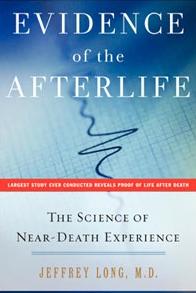 [5]Citing research from cases around the world, Dr. Jeffrey long provides new evidence of existence after death
[5]Citing research from cases around the world, Dr. Jeffrey long provides new evidence of existence after death
January 25, 2010—Near-death experiences have long been a fascinating phenomenon, prompting more questions than answers. According to a Gallup poll, between 8 to 12 million Americans—around five percent—say they have had a near-death experience. Despite these substantial numbers, most scientists are at a loss to explain these events. Dr. Jeffrey Long, a radiation oncologist, has spent the last twelve years studying over a thousand cases of near-death experience. In his groundbreaking new book, EVIDENCE OF THE AFTERLIFE: The Science of Near-Death Experiences (HarperOne, January 2010, $25.99), Dr. Long provides scientific evidence that powerfully supports what many have long suspected: near-death experiences provide proof that life continues after we die.
A nationally recognized expert who has been quoted in Newsweek, ABC News, and The Wall Street Journal, Dr. Long presents the largest scientific study of near-death experiences ever reported. Through his work at the Near Death Experience Research Foundation (NDERF), Dr. Long has gathered over 1,300 accounts of near-death experiences (NDEs) from all over the world—the largest database of its kind. The people whose stories are captured in the this database span all age groups, races, and religious affiliations and come from all over the world, yet the similarities in their accounts are as awe-inspiring as they are revealing. Dr. Long chronicles these firsthand stories in his book, and draws compelling evidence for life beyond death from them.
Many skeptics have argued that near death experiences are hallucinations brought on by illness, strong medications, or the stress of a dying brain. Others have pointed out that near-death experiences could be the result of cultural conditioning: by now, they argue, everyone has heard of the key familiar elements (out of body sensation, a bright light, a tunnel, etc). But Dr. Long says the evidence from his study refutes all of these arguments. He details nine lines of evidence, extensively corroborated by prior scholarly NDE research, that send “a consistent message of the afterlife,” including:
1) Children’s experiences. The near-death experiences of children, including very young children who are too young to have developed concepts of death, religion, or near-death experiences, are essentially identical to those of older children and adults. This refutes the possibility that these near-death experiences are shaped by preexisting beliefs or cultural conditioning.
2) Worldwide consistency. Near death experiences appear remarkably consistent around the world, and across many different religions and cultures. NDEs from non-western countries are incredibly similar to those that occur in people in Western countries, again disproving that religious beliefs and cultural norms are responsible for creating these experiences.
3) Realistic—and accurate—out-of-body experiences Out-of-body experiences are one of the most common elements of near-death experiences. Remarkably, what NDErs report seeing and hearing during these experiences of earthly events while they are unconscious or clinically dead is almost always realistic. Over 60 people who had a near-death experience in Dr. Long’s study later sought to confirm the accuracy of their out-of-body observations following their experience. All of them confirmed the complete accuracy of their observations, including observations far from their physical body and beyond any possible sensory awareness.
4) Consciousness During Anesthesia—Many near-death experiences occur while under general anesthesia—a time when any conscious experience should be impossible. The content of near-death experiences that occur under general anesthesia is essentially indistinguishable from near-death experiences that did not occur under anesthesia. Dr. Long asserts this is strong evidence that near-death experiences are occurring completely independently from the functioning of the physical brain.
Further consistent elements of near-death experiences include crystal-clear recollections, heightened senses, reunions with deceased family members and long-lasting positive effects after the person is brought back to life. “No physiological or psychological explanation of NDEs can account for what is observed in NDEs,” Dr. Long points out. Dr. Long’s conclusions are consistent with what NDErs themselves almost always believe about their own near-death experiences: that they have glimpsed an afterlife.
Belief in life after death is quite common—a recent poll revealed that 82% of Americans believe in some form of afterlife—but until now, scientific evidence was rare. With his new book, Dr. Long provides strong, science-based proof to support those beliefs.
Jeffrey Long, M.D. is a physician practicing the specialty of radiation oncology in Houma, Louisiana. Dr. Long has served on the Board of Directors of IANDS (International Association for Near-Death Studies), and is actively involved in NDE research.